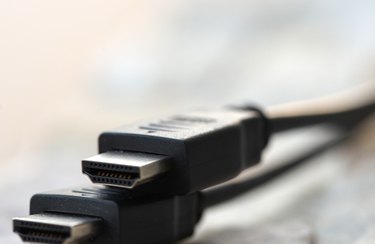
The coaxial cable is a trusted standard for connecting the cable box to the television. Many modern televisions do not have an input for this style of cable however, and an HDMI intermediary is required to to connect the coaxial cable to HDMI ports on the television. Luckily, bridging this gap is easy and the cable box will function as intended.
Check Your Connections
Video of the Day
Before converting to HDMI, check both the cable or satellite box and the television for compatible ports. Older cable and satellite boxes typically only offer the coaxial cable option only but newer models may offer a port for a direct HDMI cable. This eliminates the need for a coaxial cable altogether. Ideally, a direct connection to the cable box is used for the sake of simplicity and cost effectiveness.
Video of the Day
If the cable box only utilizes a coaxial connection, also consider upgrading the box. Contact the cable company and inquire about a free upgrade to make your box compatible with modern televisions. Otherwise, a signal converter is required as an intermediary between the two cable types. Signal converters are common and easy to order online or source through most electronics stores.
Convert Coax to HDMI
Connect one end of the coaxial cable to the cable box port labeled Coaxial Out. Coaxial cables plug into the port and screw down to tighten the connection. Plug the other end into the signal converter box. Use the port labeled Coaxial In and use the same tightening process.
Do not over tighten but make sure the nut is firmly screwed down on these connections. After completing the HDMI side of the connectors, you will test the signal and any fuzz or poor resolution may be traced back to the cable or poor connections. You can play with these connections to correct any issues after the full connection process is complete.
Connect one end of the HDMI cable to the port labeled HDMI Out on the signal box. The HDMI connections simply plug into the port, then you can connect the other end to the television HDMI port to complete the cycle. Turn on the television to test the connections. If the cable does not display within a minute or two, the television settings require a basic adjustment.
Adjust the Television Settings
The television must have the settings directed to the correct input for the coax input to HDMI output connection to function. Access the remote control and press Input or Source to scroll through the list of options. The input must match the cable to utilize the functionality of the box. Input varies for different devices like a DVD player, cable box or specific exterior media source.
Choose the HDMI 1 option and press Enter to return to the main screen display. In most cases, the cable will display within a few seconds but it can take a minute to generate the picture. Wait until the screen changes to confirm the connection is functioning. If the screen does not change, check for power at the cable box and turn on to deliver the signal through the coaxial to HDMI connection.
If the screen continues to remain blank or blue, try the HDMI 2 option. You may have plugged the HDMI cable into one of multiple ports on the back of the television. If this does not work, the cables are either loose or connected incorrectly. Return to step one and check each of the cables to ensure the correct ports are used.